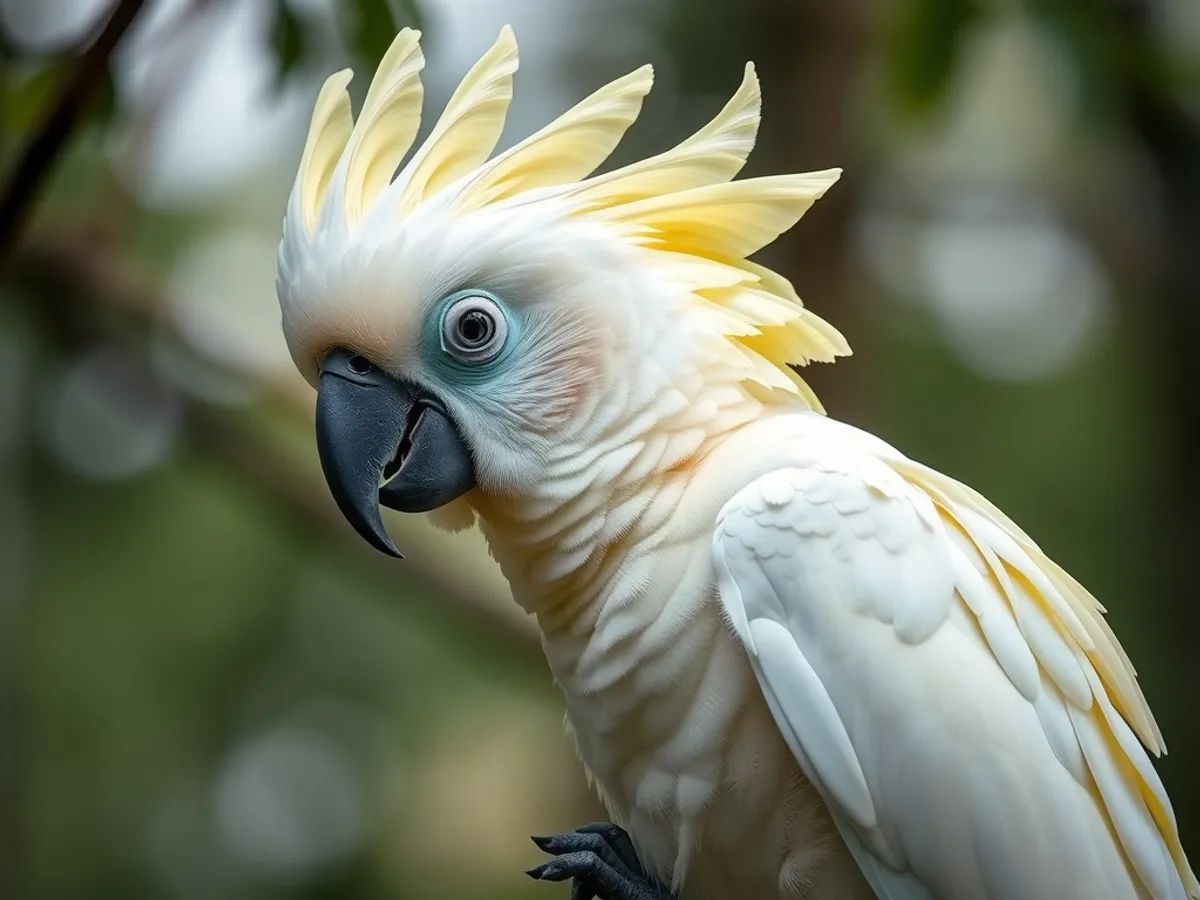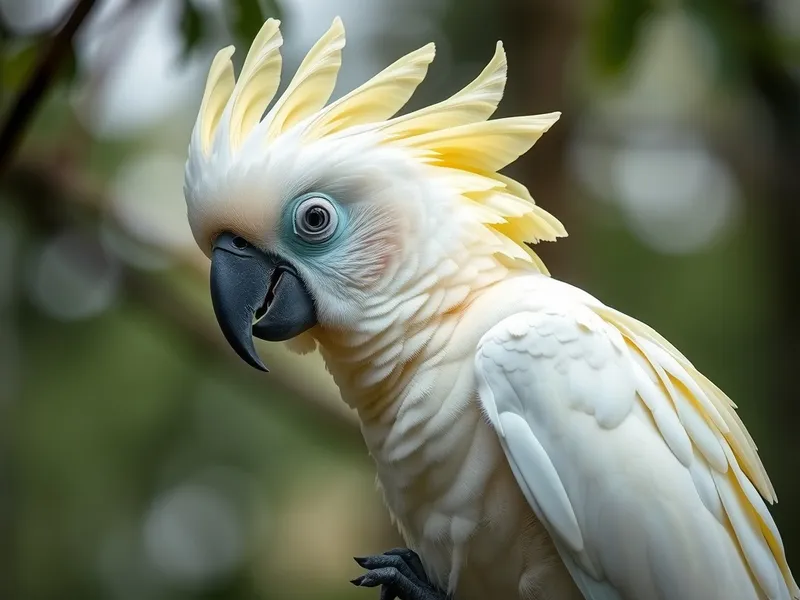
Sulphur-crested Cockatoo
Cacatua galerita

Meet the Sulphur-crested Cockatoo
The Sulphur-crested Cockatoo is a large, white parrot known for its striking yellow crest and loud, raucous calls. Native to Australia and New Guinea, these intelligent birds are highly social, often seen in large, noisy flocks in both urban and forested areas. They have strong, curved beaks which they use to crack nuts and seeds, as well as to strip bark from trees. Sulphur-crested Cockatoos are long-lived, with some individuals reaching over 70 years in captivity. Their playful nature and remarkable ability to mimic sounds have made them popular as pets, though they require significant mental stimulation.
Classification
Bird
Habitat
Woodlands, forests, and urban areas
Diet
Herbivore
Lifespan
40-70 years
Conservation
Least Concern
Weight
800-1,000 grams
📖Fascinating Facts
Iconic Crest
The bright yellow crest of the Sulphur-crested Cockatoo can be raised or lowered depending on the bird’s mood and is used to communicate excitement or alarm.
Vocal Talents
These parrots are notorious for their loud, screeching calls and are capable of mimicking a wide variety of sounds, including human words and noises from their environment.
Urban Adapters
Sulphur-crested Cockatoos have adapted well to city life in Australia, often seen rummaging through parks and gardens for food.
📋Detailed Description
The Sulphur-crested Cockatoo (Cacatua galerita) is a robust, medium-to-large parrot, typically measuring 44–55 cm (17–22 in) in length and weighing between 800–1,000 g (1.8–2.2 lbs). Its plumage is predominantly white, contrasted by a prominent, erectile yellow crest and pale yellow wash under the wings and tail. The beak is strong, curved, and grey-black, adapted for cracking hard seeds and nuts, as well as for excavating bark and wood. The eyes are dark brown in males and reddish-brown in females, with a bare white orbital ring. Sulphur-crested Cockatoos are highly gregarious, forming flocks that can number from a few individuals to several hundred, especially outside the breeding season. Their vocalizations are loud and varied, serving both social and territorial functions. These cockatoos are known for their intelligence and problem-solving abilities, often observed manipulating objects and using tools in captivity and the wild. They are long-lived, with wild lifespans estimated at 40–60 years and captive individuals documented to live over 70 years. Their flight is strong and direct, with deep, deliberate wingbeats. The species exhibits marked sexual monomorphism, making males and females difficult to distinguish visually.
💡 Did you know?
These cockatoos have been observed using tools in the wild, such as leaves to help extract seeds from hard-to-reach places.
🔬Research & Sources
Wikipedia Summary
The sulphur-crested cockatoo is a relatively large white cockatoo found in wooded habitats in Australia, New Guinea, and some of the islands of Indonesia. They can be locally very numerous, leading to them sometimes being considered pests. A highly intelligent bird, they are well known in aviculture, although they can be demanding pets.
Last Modified: 5/3/2025
🎭Behavior & Social Structure
Sulphur-crested Cockatoos are diurnal and spend much of their day foraging, socializing, and preening. They feed primarily in the morning and late afternoon, often descending to the ground to search for seeds, nuts, roots, berries, and occasionally insects and their larvae. Their powerful beaks allow them to exploit a wide range of food sources, including cultivated crops, which sometimes brings them into conflict with farmers. Socially, they maintain complex hierarchies within flocks, engaging in mutual preening (allopreening) and vocal communication to reinforce bonds. Flocks are highly cohesive, with sentinel individuals keeping watch for predators while others feed. Roosting occurs communally in tall trees, often near water. Playful behaviors, such as hanging upside down, object manipulation, and aerial acrobatics, are common, especially among juveniles. They are known for their curiosity and ability to solve puzzles, both in the wild and in captivity.
👶Reproduction & Life Cycle
Breeding occurs primarily from August to January in southern Australia and from May to September in the north, coinciding with periods of increased food availability. Sulphur-crested Cockatoos are monogamous, forming long-term pair bonds that may last for life. Courtship involves mutual preening, vocalizations, and display of the crest. Nests are typically established in large tree hollows, often high above the ground, and are lined with wood chips. The female lays 2–3 white eggs, which are incubated by both parents for about 25–27 days. Both parents share feeding duties, regurgitating food for the chicks. Fledging occurs at 10–12 weeks, but juveniles may remain dependent on parents for several months post-fledging. Suitable nesting sites are a limiting resource and can be a source of competition.
🛡️Adaptations & Survival
Sulphur-crested Cockatoos possess several adaptations for survival in variable environments. Their strong, dexterous beaks enable them to access hard-shelled seeds and nuts, strip bark, and excavate nesting cavities. Zygodactyl feet (two toes forward, two backward) provide a strong grip for climbing and manipulating food. Their loud calls serve to maintain flock cohesion and warn of predators over long distances. Cognitive adaptations include advanced problem-solving skills, memory, and social learning, allowing them to exploit novel food sources and adapt to urban environments. The bright yellow crest is used in visual displays for communication and mate attraction. Their plumage provides camouflage against the pale bark of eucalyptus trees.
📚Research Sources
🎨Cultural Significance
Sulphur-crested Cockatoos are iconic in Australian culture, frequently featured in art, folklore, and as emblems of the Australian bush. Their intelligence and expressive personalities have made them popular in aviculture worldwide, though their demanding care requirements and loud calls can make them challenging pets. In Aboriginal mythology, cockatoos are sometimes regarded as messengers or symbols of change. Their presence in urban parks and gardens has made them a familiar and charismatic species to many Australians, sometimes leading to both affection and frustration due to their destructive feeding habits.
🔬Recent Research & Discoveries
Recent research has focused on the cognitive abilities of Sulphur-crested Cockatoos, with studies demonstrating advanced problem-solving, tool use, and social learning. Notably, wild individuals in Sydney have been observed opening household garbage bins using a learned, multi-step process, with this behavior spreading culturally between flocks. Genetic studies have clarified the relationships between subspecies and their evolutionary history, indicating divergence during the Pleistocene. Ongoing research is examining the impacts of urbanization, disease (such as beak and feather disease virus), and climate change on population dynamics. Conservation efforts are also studying the effects of artificial nest boxes and habitat restoration on breeding success.
🎥Wildlife Videos

The sulphur-crested cockatoo documentary
The documentary I did for my major work. Covers most things about the Australian sulphur-crested cockatoo.
DiamondDog27

Sulphur Crested Cockatoo - Australian Bird | Short Documentary
Sulphur Crested Cockatoo is one of the most popular and iconic birds in Australia. They can live up to eighty years in captivity.
Wildlife Walk

The Amazing Life Of Cockatoo | Documentary | FSH Collection
Welcome to the vibrant world of cockatoos! In this captivating video, we dive into the unique traits that make these charming birds ...
FSH Collection

Wild Parrots Taking Over Your City | Full Documentary
Enjoy a full 50-minute documentary about parrots in urban areas. Planet Parrot: Alien invaders are infiltrating our cities. Colourful ...
Terra Mater

Cockatoo Documentary (Sulphur Crested Cockatoo) Australia 🇦🇺 #cockatoo #birds #wildlife #australia
The sulphur-crested cockatoo (Cacatua galerita) is a relatively large white cockatoo found in wooded habitats in Australia, New ...
essenceanindita

Sulphur-crested Cockatoo in the wild
This video of the Sulphur Crested cockatoo is all filmed in the wild. There is footage that demonstrates the cockatoos can feed of ...
Plumes of Oz
🌍Habitat Information
The Sulphur-crested Cockatoo typically inhabits Woodlands, forests, and urban areas environments. Sulphur-crested Cockatoos have adapted to their environments with specialized features and behaviors.
Primary Habitat:
Woodlands, forests, and urban areas
More detailed habitat information will be available soon.
🛡️Conservation Status
The Sulphur-crested Cockatoo is currently classified as Least Concern. Conservation efforts are crucial for preserving this species for future generations.
Common Threats:
- 🏠Habitat loss and fragmentation
- 🌡️Climate change impacts
- 🎯Hunting and poaching
- 🏭Human-wildlife conflict
⚠️Threats & Conservation Challenges
While the species is currently listed as Least Concern, Sulphur-crested Cockatoos face localized threats, including habitat loss due to land clearing, competition for nesting sites, and illegal trapping for the pet trade. In some areas, they are considered agricultural pests, leading to culling or deterrence measures. Urbanization has paradoxically benefited some populations by providing new food sources and nesting opportunities, but also exposes them to hazards such as vehicle collisions and poisoning. Climate change may alter the distribution of suitable habitats and food resources. Despite these challenges, the overall population is stable or increasing in many regions.
🔬Scientific Classification
Scientific Name
Cacatua galerita
Classification Hierarchy
🔍 About Taxonomic Classification
Taxonomic classification is a hierarchical system used by scientists to classify and organize living organisms based on shared characteristics and evolutionary relationships.
The system moves from broad categories (Kingdom) to increasingly specific ones, with each animal's scientific name typically consisting of its Genus and species.
📝Community Notes
Share your observations and insights about the Sulphur-crested Cockatoo with our community of wildlife enthusiasts.
Join Our Community
Sign in to share your observations and connect with fellow wildlife enthusiasts.
Sign In to ContributeNo community notes yet
Be the first to share your observations about the Sulphur-crested Cockatoo!
Explore Sulphur-crested Cockatoo
Select a tab above to learn more about this amazing animal.
📸Photo Gallery
No photos available for this animal yet.
🌟Discover More Wildlife
Continue your journey of discovery with more fascinating animals from our database
